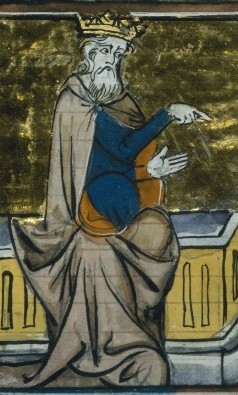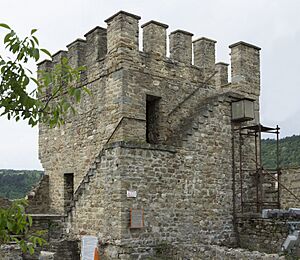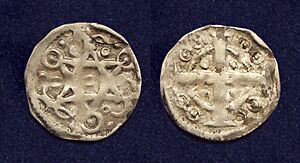Baldwin I, Latin Emperor facts for kids
Quick facts for kids Baldwin I |
|
|---|---|
| Emperor and Autocrat of the Romans | |
 |
|
| Latin Emperor of Constantinople Claimant Roman Emperor |
|
| Reign | 1204–1205 |
| Coronation | 16 May 1204 (Hagia Sophia) |
| Successor | Henry of Flanders |
| Count of Flanders | |
| Reign | 1194–1205 |
| Predecessor | Margaret I and Baldwin VIII |
| Successor | Joan |
| Count of Hainaut | |
| Reign | 1195–1205 |
| Predecessor | Baldwin V |
| Successor | Joan |
| Born | July 1172 Valenciennes, Hainaut, Kingdom of France |
| Died | c. 1205 (aged about 32–33) Tarnovo, Bulgaria (now Veliko Tarnovo, Bulgaria) |
| Spouse | Marie of Champagne |
| Issue | |
| House | House of Flanders |
| Father | Baldwin V, Count of Hainaut |
| Mother | Margaret I, Countess of Flanders |
| Religion | Latin Catholic |
Baldwin I (born July 1172 – died around 1205) was a very important leader in the Middle Ages. He became the first Emperor of the Latin Empire of Constantinople. He was also the Count of Flanders (as Baldwin IX) and Count of Hainaut (as Baldwin VI).
Baldwin was a key figure in the Fourth Crusade. This crusade led to the capture of Constantinople in 1204. It also created the Latin Empire in parts of the Byzantine Empire. Sadly, the next year, he was captured by Kaloyan, the emperor of Bulgaria, and died as a prisoner.
Contents
Baldwin's Early Life and Family
Baldwin was the son of Count Baldwin V of Hainaut and Countess Margaret I of Flanders. His family was very important in Europe. When he was young, his uncle, Count Philip I of Flanders, chose him as his heir.
In 1186, Baldwin married Marie. She was the daughter of Count Henry I of Champagne. Marie's family had strong ties to the Holy Land. Her brother, Henry II of Champagne, had been the King of Jerusalem. Her uncles were Richard I of England and Philip II of France, who had both been on the Third Crusade. Baldwin wanted to continue his family's tradition of supporting the crusades.
When his mother, Margaret, died in 1194, Baldwin became the Count of Flanders. The next year, his father died, and he also became the Count of Hainaut.
Count of Flanders and Hainaut
When Baldwin became Count of Flanders, the area was smaller than before. Some land had been given away as a dowry for his sister, Isabelle of Hainaut. Even after Isabelle died, King Philip II of France kept this land.
Baldwin spent his time as count trying to get these lands back. He allied with kings Richard I and John of England. He also allied with the German King Otto IV. These rulers also had disagreements with King Philip of France.
In January 1200, Baldwin signed a peace treaty. This treaty gave him back some of the lands he had won in war. He then became a vassal (a loyal follower) of King Philip II.
A month after the treaty, in February 1200, Baldwin decided to join a crusade. He spent two years getting ready. He finally left on April 14, 1202.
Before leaving, Baldwin made sure his lands were well-managed. He created important laws for Hainaut. These laws included a detailed criminal code and rules for inheritance. These laws are still an important part of Belgian legal history.
Baldwin left his two-year-old daughter and his pregnant wife, Countess Marie, behind. Marie was in charge of Flanders and Hainaut for two years. But in early 1204, she left her children to join Baldwin in the East. They both expected to return, but they never saw their children or homeland again. Baldwin's younger brother, Philip of Namur, took care of Flanders. Baldwin's uncle, William of Thy, managed Hainaut.
Meanwhile, the leaders of the Fourth Crusade needed money. They were convinced to go to Constantinople. A Byzantine prince, Alexios, promised them supplies and money. He wanted their help to remove his uncle, Emperor Alexios III. In April 1204, the Crusaders captured Constantinople. It was one of the strongest cities in the world.
Becoming Latin Emperor

After capturing Constantinople, the Crusaders needed a new leader. They first offered the crown to Enrico Dandolo, the leader of Venice, but he said no. The choice was then between Baldwin and Boniface of Montferrat.
Baldwin was chosen on May 9, 1204. He was young, brave, and very religious. He was also the most popular leader among the Crusaders. He was crowned on May 16 in the Hagia Sophia church. His coronation followed Byzantine traditions. Baldwin's wife, Marie, did not know about these events. She had sailed to Acre and learned about his election there. Sadly, she died in August 1204 before she could join him.
The new Latin Empire was set up like a feudal system. The emperor was the main ruler, and other princes received parts of the conquered land. Baldwin's own land included Constantinople and nearby areas. He also received several islands. However, these lands still needed to be fully conquered.
Baldwin faced a challenge from Boniface of Montferrat. Boniface wanted to be independent and not follow the emperor. This caused a disagreement between them. But they eventually reached an agreement. Boniface became the king of Thessalonica, but he was still a vassal of Emperor Baldwin.
During the winter of 1204–1205, Baldwin's brother, Henry, helped conquer more lands. But in February, the Greeks in Thrace rebelled. They were helped by Kaloyan, the tsar of Bulgaria. Kaloyan had offered an alliance to Baldwin, but Baldwin had refused.
The rebels took over the city of Adrianople. Baldwin and other leaders marched to take it back. But on April 14, 1205, the Frankish knights were defeated. Baldwin was captured by the Bulgarians. This battle is known as the Battle of Adrianople.
Capture and Death
For some time, no one knew what had happened to Baldwin. His brother Henry became the temporary ruler. It was not until July 1206 that they learned Baldwin had died.
The exact details of Baldwin's death are not fully known. It seems he was first treated well as a valuable prisoner. But he was later executed by the Bulgarian ruler. This might have happened because of a revolt in a city called Philippopolis.
A tower in the Tsarevets fortress in Veliko Tarnovo, Bulgaria, is still called Baldwin's Tower. People say it was the tower where he was held prisoner.
Back in Flanders, people were not sure if Baldwin was truly dead. His other brother, Philip of Namur, continued to rule. Eventually, Baldwin's two daughters, Joan and Margaret II, became countesses of Flanders.
Many years later, in 1225, a man appeared in Flanders claiming to be Baldwin. His claim caused many problems and rebellions. Some people who knew Baldwin said he was not the real emperor. The man was eventually found to be a serf (a peasant) named Bertrand of Ray. He was executed in 1226.
Images for kids




